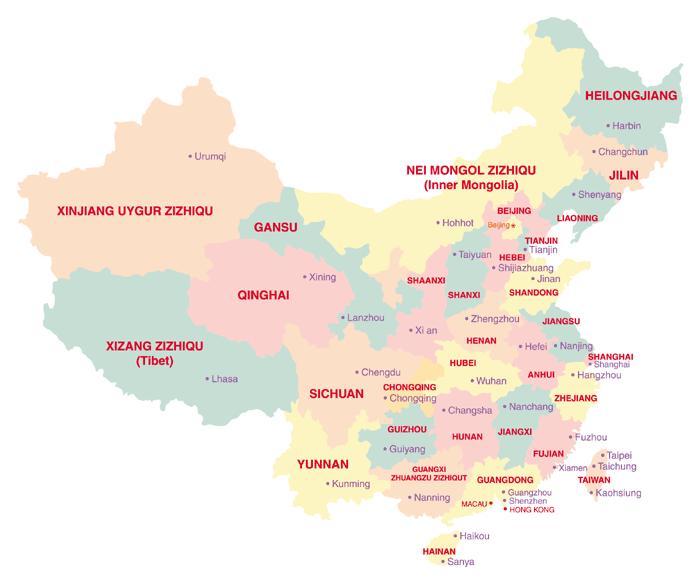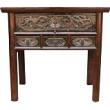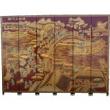- Buying Guide for Chinese Antique Furniture
- Chinese Antique Accessories
- Faux Oriental Gifts and Homeware
- Oriental Folding Screen / Room Dividers
Buying Guide for Chinese Antique Furniture
1. Age
All other things being equal, the older the piece, the more valuable it's likely to be. It could have particular historical value, it could be very rare or in exceptionally good condition, or it could have a wonderful patina.
And how do you determine the age of a lacquer piece? You need to consider three factors: the style, the workmanship, and the level of oxidation of the wood and lacquer.
Style
This is not necessarily the best indication, since the style of an old piece can be copied by later craftsmen. However, to a certain degree, it can give you some useful clues about the authenticity and value of a piece.
In classical Chinese furniture, there are two basic forms: pieces without an inset panel between the top and the apron (known as the 'waistless' form), and pieces with an inset panel (known as the 'waisted' form). Waistless furniture, such as the narrow table and the recessed-leg table, is very ancient and already existed in the Shang dynasty (16th - 11th century BC) and the Zhou dynasty (11th century - 221 BC). Waisted furniture appeared much later.
In many Ming dynasty paintings, we can see that the interiors were quite simple and the furnishings rather sparse. It was not until the Qing dynasty that rooms became increasingly crowded and the furniture more elaborate.
Ming designs (1368 - 1644) are relatively uncomplicated, with the basic outline of the form usually consisting of straight lines and simple curves. Common features include horse-hoof feet, giant arm braces, ice-plate edges, protruding arms etc. Qing designs (1644 - 1911) are usually more complex, with numerous small elements and elaborately carved decoration.
Workmanship
Not surprisingly, craftsmen in different periods used different kinds of techniques, which tended to change every 40 to 50 years.
Oxidization of the wood and lacquer
When buying wooden furniture, collectors need to consider the extent of wear and tear on an item (though a piece that was known to have been used by a famous or powerful person can be valuable even if it is not in immaculate condition).
As for lacquer finishes, they can be considered a common denominator in traditional Chinese furniture. Throughout China, most furniture was finished with lacquer coatings to provide durable, sealed surfaces as well as decorative effects - a technique practised since ancient times. In fact, lacquer is one the best indicators of the age of a piece, since lacquer ages and oxidizes at predictable, measurable rates.
Lacquering processes varied from period to period. In the Song and Ming periods, for instance, lacquer was generally applied over a fabric underlay (daqi), which was soaked in a mixture of thickened lacquer and pasted onto the surface of the wood. Sometimes the entire surface was covered with fabric; sometimes small strips were pasted over the joints only.
The base-coat was generally composed of raw lacquer mixed with a binder powder made of horn, bone, shell, stone, brick, pottery or charcoal. This thickened filler coat had high adhesive properties as well as stability and hardness. However, this labour-intensive technique eventually fell out of fashion, and in the Ming and Qing periods customers preferred pieces with only a thin layer of lacquer and no fabric underlays.
The finely crackled surfaces and mellow tones of lacquer finishes have been a study of connoisseurship for centuries
2. Material
Timber and lacquer are the most widely used materials in furniture, with the lacquering technique or process having a significant affect on the value of a piece. Other materials used are stone, marble, shell, coral, pearl, ivory, bone, gold leaf or various metals. Again, all other things being equal, the harder the timber, the higher the value of the furniture (for instance, huanghuali is regarded as the hardest and most expensive timber, while pine is the softest and least expensive).
Timber can be classified into six categories. In descending order of hardness (and value), they are:
1. huanghuali (yellow rosewood), zitan (sandalwood), jichimu (Chicken Wing wood)
2. hong-mu (blackwood), tielimu (ironwood), jarjingmu, wu-mu (ebony), ying-mu (burl), hua-mu (gingko)
3. ju-mu (southern elm wood), hetaomu (walnut wood), huang-yang mu (box wood), lung-yan mu (tiger-skin wood), zuo-mu (Oak)
4. nan-mu, kundianmu, shizimu (persimmon)
5. yu-mu (elm), zhang-mu (camphor), hualimu (rosewood), huai-mu (Locust), tao-mu (peach), li-mu (Pear)
6. pai-mu, song-mu (pine), shang-mu (cedat), qiu-mu (Catalpa), duan-mu (poplar), Bai-yang mu (paulownia), wu-tong (Kiri)
The better the original condition of the piece, the higher its value will be. If a piece of furniture is missing some parts, so that a lot of replacement work is needed, the relative value is lower. If restoration is carried out only on the joints, the aprons and near the bottom of the piece, it is generally accepted as being intact. It is desirable if the fittings (in most cases, the brassware) are original. Patina is valued since this can indicate how good the condition of a piece is, and sometimes its age.
Craftsmanship is an important factor in determining the value of a piece of furniture. Sometimes, when the craftsmanship is superb, a piece made out of elm wood can be more valuable and collectable than a piece made out of hong-mu (blackwood), all other things being equal.
This is actually a supply-and-demand issue - if a certain style is not easily available in the market then pieces in that style are considered collectable, and their value in the market goes up.
Faux Leather Gifts and Homeware
This category includes a range of new hand made Chinese Style Gifts and Homeware. This classical style range of collections are made using old traditional Chinese techniques, which was developed 1200-1500 years ago in the Tang Dynasty Era, painted and embossed on Leather wood box. These days the old technique has been used for a wide range of new design items including furniture.
The leather is wrapped around the wood and bound tightly so that the skin is smooth and perfectly formed to the piece. Stylish brass fixtures and handles complete the exterior. Inside the boxes are lined with aged Chinese paper filled with characters, adding to the authenticity and feel of the products.
Front and sides of most of pieces are painted with beautiful and traditional Chinese paintings of golden Butterflies, Birds flying beyond flowers, golden Dragonflies flying beyond lotus, or elegant Peacock etc. In Chinese culture, these all represent luck and happiness. Also, lacquer had put on the paintings for protection.
History of folding screens starts in China, where they appeared in the 14th century. These sophisticated pieces of furniture were made in wide range of sizes, from extremely large oversized folding screens that were used in spacious palaces, to miniature decorative screens that could comfortably fit on a tabletop or wall hanging.
Folding screens can be used as room dividers which ware constructed from several panels attached to each other. The most popular in VII century China room dividers were six or eight panels folding screens. Chinese masters are famous for their complex ancient lacquer application techniques. Most known technique used in creation of folding screens - "naciju" - is a labor intensive multi layered lacquer application technique with gold leaf inserted into the lacquer on the different levels. Masters applied up to 30 layers of lacquer and each level had a unique gold leaf pattern. As a result - a magically glowing surface of the screen that exudes energy. Another popular unique decorative technique used by Chinese artisans in creation of folding screens is dimensional carving on the clay surface.
Folding screens that are made by using this method are known as Coromandel screens. Each panel of coromandel screens was made from wood and covered with many layers of soft clay followed with multiple layers of lacquer. Then opulent designs with landscapes, flora and fauna motives, and calligraphy writing, were skillfully engraved in a different relief (high and low) into the screens panels, creating a breathtaking three dimensional effect. The Coromandel screens were then painted and embellished with gold or silver leaf. The unique screen making techniques passed from generation to generation and are widely used and popular today.
There exist two major styles of traditional Chinese furniture: The lacquered furniture with sculpture and painting of vivid and variable colors, it fulfills a pre-eminently decorative role, and traditional furniture that is much more sober, with a facade of almost unique color. It is frequently used by families in the ancient China.

Copyright Admiralty Antiques 2014 all rights reserved








